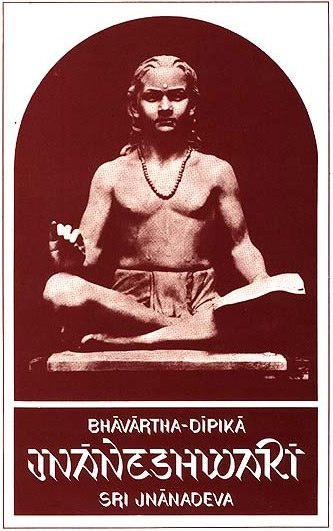Jnaneshwari (Bhavartha Dipika)
by Ramchandra Keshav Bhagwat | 1954 | 284,137 words | ISBN-10: 8185208123 | ISBN-13: 9788185208121
This is verse 13.14 of the Jnaneshwari (Bhavartha-Dipika), the English translation of 13th-century Marathi commentary on the Bhagavad-Gita.—The Dnyaneshwari (Jnaneshwari) brings to light the deeper meaning of the Gita which represents the essence of the Vedic Religion. This is verse 14 of the chapter called Kshetra and Kshetrajna Yoga.
Verse 13.14
Verse 13.14: “That which is revealed (as the basis) of all sense-functionings, that which is (itself) beyond the ken of all senses; detached (and yet) supporting everything; so likewise, devoid of the Gunas (Constituent-aspects) and (yet) the experiencer of them: (892)
Commentary called Jnaneshwari by Jnaneshwar:
“Oh Kiriti it (Supreme Brahman) pervades the universe just as the sky pervades all space; or just as the thread pervades the entire linen in the form of chequered cloth; or just as liquidity dwells in water in the watery form; or just as light dwells in the lamp in the lampform; or just as the fragrance of camphor exists in camphor in the camphor-form; or just as actions dwell in the body in the bodyform; in short, Oh Pandava, just as gold abides in every particle of gold, in that way the Supreme Brahman pervades all externally and internally. Yet, so long as gold is in the particle form (ravā) we call it particle, but as soon as that form is changed, it becomes only gold. Even though the current might run in a zig-zag course, yet the original water (flow) remains straight; or even though the iron gets red hot by fire (heat), yet fire does not constitute iron; or the sky appears round when enclosed in an earthen pot or appears four-cornered when seen from the interior of a (four-cornered house), but those round and square forms are not of the sky itself; in that way Supreme Brahman, even though apparently undergoing transmutations, yet in reality is never so affected. Supreme Brahman,
Oh Dhananjaya, is felt to be formed out of the mind, the senses, and the three Gunas (constituent aspects) yet neither the Gunas nor the senses consitute Supreme Brahman, in the way the sweet taste of the jaggery does not exist in the form of its mould (but exists in the jaggery itself). Clarified butter exists in milk, in milk form, yet milk is not certainly the clarified butter. In that way, the (qualifying) attributes such as the Gunas and the senses, in no way affect Supreme Brahman, (and) bear this in mind. We give different names, such as (screw) flower etc. (phirakīce phūla) to different forms (ornaments) of gold, yet the original gold remains as original gold in any such form. To speak in plain Marathi language, Oh Dhananjaya, Supreme Brahman is entirely distinct from the three Gunas and the senses. Name, aspect, genus, action and (all such) distinctions are all attributes of the forms and do not apply to the essence (Supreme Brahman).
Supreme Brahman is neither the Gunas themselves nor is it in any way, connected with Gunas: yet the Gunas (erroneously) appear to be in Supreme Brahman. It is on account of such (erroneous) appearance, Oh Kiriti, that the deluded ones hold that the Guna attributes reside in Supreme Brahman. Supreme Brahman possesses (them) in the way the sky supports the clouds or the mirror supports the reflection, or in the way the Sun-reflections are supported by water or the Sun’s rays support the mirage. In that way the unmanifest (Supreme Brahman) supports the Guna attributes without in any way contacting them. But it is unsubstantial and unreal even though perceptible to the illusive vision. The experiencing of the Gunas by the qualityless, is like a poverty-stricken person enjoying sovereignty in a dream. Therefore, let there be no mention even of the association with, or experiencing of, Gunas by the qualityless.
